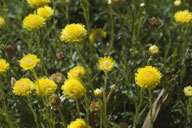In Flower This Week
A news sheet prepared by a Gardens' volunteer.
Numbers before each plant refer to temporary IFTW labels in the gardens.
Numbers in square brackets [ ] refer to garden bed Sections. Plants in flower are in bold type.
View past issues of 'In Flower This Week'.
17 February 2016
Helichrysum rutidolepis
click for larger image |
Only a short walk today from the Visitor Information Centre (VIC) to the environs of the café.
- As you leave the VIC look left across the paving to see Helichrysum rutidolepis [Section 212], or Pale Everlasting, which has yellow ball flower heads on grey foliage. This plant is native to southeastern Australia, including Tasmania.
- Now turn to see on your right Correa alba [Section 221] with grey-green leaves and white star flowers. This correa is a popular and reliable plant in the garden. It is native to eastern coastal regions of Australia from northern New South Wales to Tasmania and eastern South Australia.
- On the right of the VIC entrance in a pot is Banksia victoriae [Section 221], or Woolly Orange Banksia, with attractive grey-green toothed foliage and very large orange flower heads. This plant is found around Geraldton and Perth in Western Australia.
- Just before you cross the bridge to the café on your left is Xanthorrhoea glauca subsp. angustifolia [Section 60], a large grass tree with rippling grey-green linear foliage. This plant is found in the wild in Victoria, New South Wales and Queensland.
- On your right is an even larger grass tree, Xanthorrhoea arborea [Section 60], which can grow a trunk up to two metres tall. This plant is found in a restricted area from Rylstone to Sydney in New South Wales.
- Go over the bridge and cross the lawn near the café to see on your right Correa ‘Canberra Bells’ [Section 243], a low spreading bush with red bell flowers with white tips. This cultivar was developed by local plant breeder Peter Ollerenshaw to mark the Centenary of Canberra in 2013.
- Further on your right is Correa ‘Summer Belle’ [Section 243], with pink bell flowers with greenish tips. This cultivar was developed from seedling that arose in the garden of Neil Marriott in Stawell, Victoria.
- Again on your right is Callistemon viminalis ‘Wild River’ [Section 243], a small tree with bright red “bottle-brush” flower heads.
- Cross the lawn to the path to the Crosbie Morrison Building to see on your right Crowea exalata ‘Southern Stars’ [Section 240], a dainty bush with dark green foliage and pink star flowers.
- On your right is a Banksia species [Section 240], with stunning new brown cones with reddish tops.
- Turn left up the hill to see on your right Callistemon ‘Baroondah Station’ [Section 310], a tall shrub with a graceful pendulous habit and pink flowers.
- Also on the right is Callistemon viminalis [Section 310], a medium-sized tree with drooping foliage and brilliant red flowers. This plant is also known as Weeping Bottlebrush, and often grows along watercourses in its native New South Wales and Queensland.
- On your left is Crowea ‘Cooper’s Hybrid’ [Section 240], a neat bush with dark green foliage and pink star flowers.This cultivar is a cross between Crowea exalata and C. saligna and arose as a seedling in the garden of Mrs. R. Cooper of Turramurra, New South Wales in 1983.
- Also on your left is Thomasia petalocalyx [Section 240], or Paper Flower, a small bush with pinkish-mauve flowers and striking brown anthers. It is a native of the drier parts of Victoria, South Australia and Western Australia.
- Turn right to see on your left Banksia spinulosa var. spinulosa [Section 131], or Hairpin Banksia, which is found in open forests and woodlands of the coasts and mountains of New South Wales and Queensland.
Rosalind Walcott
![Director of National Parks [logo]](../../../../images/dnp_90px.gif)







